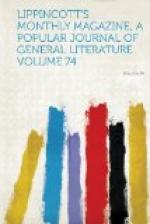The crisis of 1873 seems destined to be the most memorable of all the purely financial panics in the history of the United States. Certainly no panic, involving such widespread disturbance of the ordinary course of business was ever before known, either in the Old World or the New, on a paper-money basis, for the collapse of the speculative bubble at Vienna a few months earlier was a mere trifle in comparison, although it set us the example of throttling a panic by closing the avenue to the exchange of securities. I mention Vienna as a case in point, for Austrian finances are such that the nation is kept in a chronic state of suspension, and I am not aware that any prominent bourse in Europe except the one mentioned ever adopted a similar proceeding in a like emergency.
This panic was not the result of paper-money inflation, nor of inflated values, nor of reckless over-trading, nor of in-ordinate speculation. The trade and commerce of the country were in a sound and prosperous condition, and the prices of securities in Wall street were, on the average, hardly in excess of real values, and in some instances a little below them. It is true that the old trouble of tight money was beginning to be felt, and the bears on the Stock Exchange were trying to aggravate the natural monetary activity which invariably attends the flow of currency westward to move the crops early in the fall of the year, by “locking up” greenbacks and otherwise. On the 6th of September the weekly return of the New York banks, State and National, belonging to the Clearing-house, showed that their legal-tender reserve had fallen to a little less than half a million above the twenty-five per cent., which the National banks in the large cities are required by the “National Currency Act” to keep on hand against their deposits and notes; but this excited no apprehension, and hardly occasioned surprise among those aware of the drain of money for crop-moving purposes—the outward flow from Chicago and Cincinnati to what I may call the agricultural districts having been much larger than usual this season. After the four months of unparalleled and continuous stringency experienced in the previous winter and spring, when rates varying from a sixty-fourth to seven-eighths of one per cent., per diem were paid in addition to the legal seven per cent, per annum for call loans on first-class collaterals—during all of which time stocks were firmly supported—it is not to be supposed that Wall street or the general public felt much uneasiness about the loan market or the financial prospect generally. The deposits in the New York banks not only showed no falling off, but were over two hundred and twelve millions against two hundred and nine millions at the corresponding period in the previous year. The fall trade had opened auspiciously; the earnings of the railways were from five to fifteen per cent., larger than in 1872; the crops were abundant—the cotton crop, in particular, being estimated at four millions of bales—and it was supposed that the experience of stringency just referred to had placed the banks, the speculative community and the merchants in a conservative attitude, prepared against a recurrence of dear money, and that therefore we should escape a repetition of the painful ordeal.




